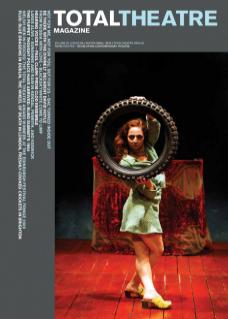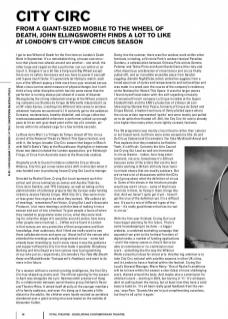I got to see Wheel of Death for the first time on London’s South Bank in September. It’s a remarkable thing, a house-size structure that pivots two wheels around one another – one small, the other large and caged so that a performer can run within or on top of it. Imagine it as a bit like a fairground Big Wheel except there are no safety harnesses and you have to power it yourself and it goes much faster. It’s genuinely terrifying to watch, each turn of the Wheel rasping a little more from your strained nerves. Most circus carries some measure of physical danger, but I can’t think of any other discipline which has the same sense that the performer is running always just ahead of a wave of disaster. (Recognising the strong malevolent energy of the Wheel, presenting company Les Studios de Cirque de Marseille interpreted it as an SF-style device, crashing into different time zones to enslave whatever humans encountered it.) It certainly got to the audience. Screams, exclamations, breathy disbelief, and a huge collective wwwoooaaaaaaaaahhh whenever a performer picked up enough pace to hit an anti-grav dead point at the top of a rotation, airborne within his wheeled cage for a few terrible seconds.
La Roue de la Mort: La Trilogie du Temps closed off the circus strand of the National Theatre’s Watch This Space festival, and, with it, the longer, broader City Circ season that began in March with NoFit State’s Tabú at the Roundhouse. Highlights in-between those two dates included the London appearance, pre-Edinburgh Fringe, of Circa from Australia (seen at the Riverside studios).
Originally an Arts Council initiative called the Circus Venues Alliance, City Circ got a new name and a shift in direction when it was handed over to producing house Crying Out Loud to manage.
Directed by Rachel Clare, Crying Out Loud represent such theatrical and circus luminaries as James and Aurélia Thiérrée, Circo de la Sombra, and TPO Company, as well as taking on the administration of individual projects like the Europe-wide funding initiative Jeunes Talents Cirque. With City Circ, they were moreor-less given free reign to do what they wanted. ‘We called a lot of meetings,’ remembers Pam Vision, Crying Out Loud’s Associate Producer, ‘a lot more meetings, with the idea of making it into a season and sort of into a festival. To give people a focus of when they needed to programme some circus, what they were looking for, what the shape of it would be around London, how many other people were involved. […] What we’ve found in London is that venues are very protective of their programme and their knowledge, their audiences. And I think we really want to see them collaborate more and open up.’ About half of the venues who attended the meetings actually programmed circus – some had already been intending to, but in many cases it was the guidance and support offered by City Circ that made it possible: Broadway Barking and Arts Depot are two venues new to programming circus who put on, respectively, Circomedia’s You Take My Breath Away and Muziektheater Transparent’s Feedback, and want to do more in the future.
For a season without a central curating intelligence, the first City Circ has shaped up pretty well. The official opening for the season in April was alongside the Lyric Hammersmith premiere of Hang On, a collaboration between aerial theatre group Ockham’s Razor and Theatre-Rites. It aimed itself directly at the younger members of its family audience, and even if in doing so it became a little distant to the adults, the children were loudly excited as aerialists clambered over a giant turning structure based on the mobiles of Alexander Calder.
Going into the summer, there was fine outdoor work within other festivals, including, at Victoria Park’s outdoor festival Paradise Gardens, a collaboration between Chinese Pole artists Gemma Palomar and Telma Pinto and Avant Garde Dance (the risky and often disastrous combination of street dance and circus finally pulled off), and an incredible ensemble piece from Gandini Juggling, Gandini NightClubs, which united ten jugglers from a broad spectrum of styles and temperaments and nationalities and was made in a week over the course of the company’s residency at the National for Watch This Space. It was the larger pieces I found myself least taken with: the self-regarding virtuosity of renowned French company Le Cirque Invisible at the Queen Elizabeth Hall, and the ENO’s production of L’Amour de Loin (directed by Daniele Finzi Pasca, formerly of Cirque du Soleil and Cirque Éloize), a leaden two hours of thinly plotted opera where the circus artists represented ‘spirits’ and were mostly just pulled on to do splits then floated off. Still, the City Circ hit rate is already a lot higher than many other, more tightly curated, festivals.
The ’09 programme was mostly circus theatre rather than cabaret or act-based work, but there were some exceptions (the So and So Circus Cabaret and Circomedia’s You Take My Breath Away) and Pam explains that they needed to be flexible: ‘Yeah, it’s difficult. Certainly the Arts Council but Crying Out Loud as well are interested in circus theatre – indoor, hour-long entertainment, not acts. Sometimes it’s difficult because some of the artists that are the best artists working in Britain still only have twenty minute shows that are mostly outdoors. But we’ve had a lot of discussions within the [City Circ] group about what the definition of circus is. Some of the shows in the brochure people would say aren’t circus – some of them have no tricks in them, no flying in them, things like that. And we haven’t quite got it yet – haven’t got the crux of the definition yet. It’s a difficult one. It’s such a mix of different types of theatre – it’s really good theatre that has its root in circus.’
With the first year finished, Crying Out Loud have begun planning for the future. There’s some housekeeping to be done – a bigger website, a combined marketing campaign that expands from print to the furthest frontiers of digital media, a number of funding applications – and if the money comes in, they’d like to be able to commission or co-commission new work – something like the way the Without Walls consortium does for street arts. Another big ambition is to take City Circ national with satellite seasons in other UK cities, and in London to have a festival within the festival. Crying Out Loud’s General Manager, Marie Remy: ‘One of Rachel’s ambitions will be to have within the season a short blast of more challenging work, themed around the body. And maybe also a commission for children’s work – starting in 2010, but touring in ’11.’ It’s all dependent on pulling down the money, but at least now they have a solid base to build on. ‘It’s all been really good feedback from the venues,’ says Pam. ‘Sounds like we’re just complimenting ourselves, but they’re all up for it again.’
City Circ took place at various venues throughout London from April to August 2009. See www.citycirc.com
Crying Out Loud, established in 2002, is an organisation, led by creative producers, that creates memorable events for festivals and theatres in the UK, USA, Australia and Europe. See www.cryingoutloud.org


